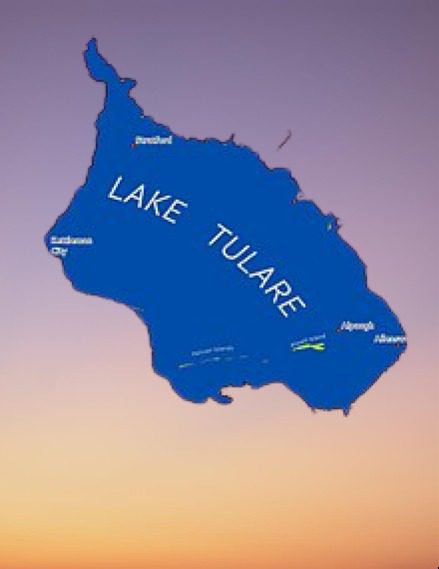California Lake Reappears: In an astonishing turn of events, Tulare Lake, which had been dormant for the past 40 years, has resurfaced following a series of intense storms in California. This unexpected resurgence has captivated the attention of experts and residents alike, defying expectations of a swift disappearance. With its reappearance, Tulare Lake has brought significant challenges and implications for the surrounding region.
The Persistence of Tulare Lake
Despite receding water levels, experts predict that Tulare Lake will take at least a year to evaporate entirely. This extended timeline emphasizes the lasting impact of the lake’s presence and raises questions about the region’s future.
Agricultural Losses and Cleanup Efforts
The sudden reappearance of Tulare Lake has caused substantial agricultural losses, totaling hundreds of millions of dollars. Flooded farmlands have led to damaged crops, disrupted livestock operations, and financial setbacks for farmers. Furthermore, once the water recedes completely, an extensive cleanup effort will be necessary to address the remnants of flooded infrastructure.
Pacific Gas and Electric’s Role
Pacific Gas and Electric (PG&E) has played a critical role in salvaging vital electrical infrastructure from the lake bed. By deploying divers and helicopters, PG&E has been able to retrieve submerged equipment, ensuring the safety and reliability of the electrical grid in the area.
California’s Weather Extremes and Climate Change
Tulare Lake’s resurgence highlights the consequences of extreme precipitation in California, exacerbated by the ongoing effects of climate change. The state’s weather patterns have long oscillated between wet and dry periods, but with the warming climate, these fluctuations are becoming more pronounced. Tulare Lake serves as a potent symbol of the challenges faced by California’s communities and ecosystems in the face of shifting weather patterns.
Changing Landscape and Current Conditions
Satellite measurements conducted by the California Department of Water Resources reveal the expanding dimensions of Tulare Lake. Initially covering nearly 114,000 acres, the lake’s levels have gradually decreased since early June, resulting in an area of approximately 111,000 acres. These measurements provide valuable insights into the lake’s behavior and assist in monitoring its future trajectory.
Also Read: New Study Reveals Surprising
Murky Waters and Environmental Concerns
While Tulare Lake’s reappearance brings hope, it also presents environmental challenges. The lake’s waters have become murky and polluted due to the presence of farm fertilizers, fuel, and other pollutants. Addressing these pollution issues will require concerted efforts to safeguard the ecological health of the lake and its surroundings.
Former Glory and Wildlife Resurgence
Tulare Lake, once the largest body of freshwater west of the Mississippi, holds historical significance. Its revival offers an opportunity for the return of wildlife and the restoration of wetlands. Efforts by environmental advocates and the Tachi Yokut Tribe are underway to preserve water in the lake and foster the reestablishment of wetland habitats, promoting biodiversity and supporting native species.
Advocacy for Water Preservation
Some environmental advocates and the Tachi Yokut Tribe have voiced the importance of water preservation in Tulare Lake. By retaining water in the lake and reviving wetlands, there is potential to create a balanced ecosystem that supports abundant wildlife and provides ecological benefits to the region.
Agricultural Damages and Economic Impact
The flooding associated with Tulare Lake’s resurgence has inflicted substantial damages on the agricultural sector. Farmers in the region have faced significant losses, with estimates suggesting that agricultural damages in Tulare County alone could exceed $300 million. Crops such as tomatoes, cotton, and pistachios have been submerged and destroyed, necessitating the relocation of livestock to safer areas.
A Narrow Escape and Effective Collaboration
Despite the challenges posed by the flooding, the region narrowly avoided a more catastrophic outcome. Cooler weather during the spring season slowed down the snowpack melt, mitigating the risk of further flooding. Effective collaboration among state, local, and federal officials played a crucial role in developing and implementing strategies that minimized the damage caused by the lake’s resurgence. Pumping, water diversions, and temporary adjustments to water usage were among the measures taken to protect lives, infrastructure, and agricultural operations.
Residents’ Mixed Emotions
For residents living near Tulare Lake, this resurgence has elicited mixed emotions. While they appreciate the opportunity to witness the lake’s revival, they are also saddened by the destruction caused to homes, farms, and the local economy. The sight of mile after mile of water has provided a unique glimpse into the pre-drainage landscape, reminding them of the region’s historical connection to the lake.
Conclusion of California Lake Reappears
The enduring presence of Tulare Lake challenges us to reflect on the delicate balance between human activities and the forces of nature. The resurgence of Tulare Lake offers valuable lessons about resilience, adaptation, and the need for effective collaboration in the face of changing environmental conditions. As California continues to grapple with the complexities of its weather patterns and the impacts of climate change, the experiences and insights gained from Tulare Lake’s reappearance will inform future planning, water management strategies, and environmental stewardship efforts in the region.
Our Reader’s Queries
What lake in California is coming back?
The recently refilled Tulare Lake, following 40 years of dryness, will require at least a year to completely evaporate, according to experts. This phenomenon occurred due to the onslaught of atmospheric river storms in California.
What California lake reappeared after 100 years?
Once the biggest freshwater lake west of the Mississippi, Tulare Lake has been brought back to life by a rainy California winter. Whole communities are now submerged beneath its waters.
Has a dormant lake in California reappeared?
After decades of dormancy, a lake in California has been replenished by a succession of fierce storms and melting snow from unprecedented snowfall in the state.
Why was Tulare Lake drained?
During the late 1800s, Tulare Lake lost its water when its rivers were diverted for farming and city water. Today, it’s mostly dry with some leftover wetlands and marshes.

